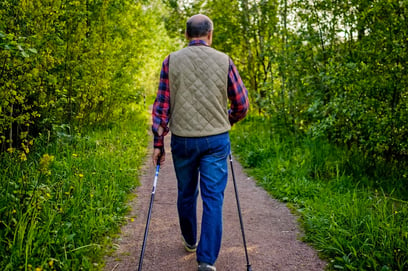.png?width=482&name=COPD%20and%20Anxiety_%20(3).png)
Chronic obstructive pulmonary disease (COPD) is a lung condition that affects millions of people across the country. Advanced stages of COPD can lead to debilitating symptoms such as breathlessness, wheezing, and chest tightness. Since there is no cure for COPD, managing its symptoms is the best way to prevent it from progressing.
With that being said, it’s no surprise that many people afflicted with COPD also develop anxiety from their condition. In tandem with physical symptoms, knowing that the condition can’t be reversed can lead to severe anxiety and reduced quality of life. This is a common response and should be taken just as seriously as the disease itself.
In the following sections, we’re going to take a look at how exactly COPD can lead to anxiety, how anxiety can make COPD symptoms worse, and what you can do to prevent this negative feedback loop.
How COPD Can Cause Anxiety
Much like how you feel hungry when you haven’t eaten all day or thirsty when you’re dehydrated, your body will exhibit symptoms when it’s low on oxygen. Short-term symptoms like the need to stop and rest more frequently while exercising are easy to notice, however, anxiety tends to be more of a long-term reaction that can be more difficult to detect.
It’s normal to experience anxiety to some extent throughout our daily lives and it can even be used to motivate us to make a change. For example, if you have dirty dishes piling up in your sink, you may experience enough anxiety to clean them and put them away, leaving you feeling relieved and accomplished.

On the other hand, chronic and severe anxiety, like what you may experience as a result of COPD, is not healthy and can even contribute to the physical symptoms you’re experiencing.
According to a study published by the Department of Health and Human Services (HHS), instances of anxiety and depression are “generally higher than those reported in other advanced chronic diseases,” and are much higher than the prevalence of anxiety in the general public, especially during later stages of the disease.
We’re going to take a look at just a few of the main reasons COPD leads to anxiety and what you can do about it.
Shallow Breathing
On average, a healthy person takes between 12 to 20 breaths per minute. If you take more breaths than this, it is known as tachypnea or hyperventilation. Although on the surface, this may not seem like a serious issue, for a COPD patient, it may be the root cause of their anxiety.
According to the Yearbook of Intensive Care and Emergency Medicine, patients with COPD demonstrate shallow and rapid breathing that often results in hypercapnia or carbon dioxide retention. This shallow breathing is usually the result of diminishing lung elasticity and general lung function and can result in breathlessness and increased blood pressure.
Whether it occurs as an isolated incident or chronically like in progressive lung disease, hypercapnia causes a stress response in the body that leads to anxiety. It’s your brain’s way of telling you that something’s wrong and your body isn’t getting the oxygen it needs.
COPD Exacerbations
A COPD exacerbation can result from anything that causes COPD symptoms to worsen. For example, inhaling an irritating substance like pollution or contracting an illness that leads to inflammation of the airways.
Exacerbations like these can lead to a sudden onset of anxiety commonly called panic attacks. If you’d like more information on treating and preventing COPD-induced panic attacks, our blog titled COPD and Panic Attacks: How to Manage Your Anxiety will be a great resource for you.

Aside from panic attacks, however, you might have anxiety about experiencing another exacerbation. For example, if you were outside when an exacerbation occurred, you may have a fear of going outside, especially in busy areas where you feel a lack of control. If this persists long enough, you could be missing out on a lot of the things you enjoy doing in your life.
Feelings of Guilt
One of the most common causes of anxiety in people with chronic respiratory conditions is a sense of guilt. Some patients may feel guilty about their increased dependency on loved ones or about an activity that they are no longer able to do with their condition.
Over time, feelings of guilt can lead to COPD patients not asking for the help they need or distancing themselves from friends and family in order to regain some independence.
The Breathlessness-Anxiety Cycle
When COPD and anxiety combine, they can create a cycle of negative feedback. Feelings of breathlessness may provoke panic, causing you to feel more anxious, thus making it harder to breathe. When you get caught up in this cycle, it may be difficult to distinguish the symptoms of anxiety with the symptoms of COPD.

If you believe you’ve found yourself in this breathlessness-anxiety cycle, it’s important that you speak with a doctor before making any decisions about your health. If you take medication for anxiety, it may exacerbate your COPD symptoms or vise versa. Your doctor will help you find the right balance and ensure that you aren’t making symptoms worse.
How To Reduce COPD-Induced Anxiety
Fortunately, there is ample research done on anxiety and many resources out there for you to go to if you’re experiencing COPD-related anxiety. But a good place to start would be to simply try to recognize the signs of anxiety and how they might be affecting your COPD symptoms.
If you notice that you’re stuck in a loop of negative thoughts surrounding your condition, you’re most likely experiencing anxiety and you should speak with a doctor immediately. However, in the meantime, try some of these tips to reduce anxiety, and ideally, improve COPD symptoms at the same time.
Pulmonary Rehabilitation
Pulmonary rehabilitation (PR) is the process of improving lung function and reducing the symptoms of chronic respiratory conditions through exercise and education. In pulmonary rehabilitation, you will learn more about how your lungs work and how to exercise effectively and safely.

By attending pulmonary rehabilitation, you will not only learn techniques for breathing more effectively, but you will be surrounded by a group of people who are facing similar challenges in their lives. This is a great opportunity to meet some new people and socialize which, in and of itself, may help you alleviate feelings of anxiety.
Breathing Exercises
Although it may seem silly to practice your breathing, it’s incredibly important and can help you live a happier and more fulfilling life, especially if you have a chronic respiratory condition like COPD.
Taking the time to understand how your breathing and posture affect your oxygen intake can be hugely beneficial. And as a result, you’ll be able to reduce symptoms of anxiety significantly. There are a lot of different breathing exercises you can try, however, for COPD patients, diaphragmatic breathing, deep breathing, and pursed lips breathing tend to be the most effective.

Diaphragmatic Breathing
The diaphragm is the muscle under the chest cavity that’s responsible for expanding the lungs, allowing air to flow in. Due to the reduced lung function in COPD patients, however, many people develop a rapid, shallow breath that doesn’t use the diaphragm muscle. Diaphragmatic breathing will help you concentrate on “breathing from the stomach” rather than breathing from the chest.
Deep Breathing
Once you’ve mastered diaphragmatic breathing, you may want to give deep breathing a try. Similar to diaphragmatic breathing, deep breathing requires you to take in a lot of air. However, with this exercise, you will breathe in slowly until your lungs are completely filled and then release it slowly. Ideally, you’ll want to be lying on your back to practice deep breathing exercises.
Pursed Lips Breathing
With this breathing technique, you will inhale slowly through your nose and release it slowly through pursed lips. The purpose of the pursed lips is to increase resistance in the airways, keeping them open while you breathe. Breathing in this way will help you calm down and reduce anxiety.
For more detailed information on breathing techniques, check out 6 Effective Breathing Techniques and Exercises for COPD.
Get More Sleep
One of the main causes of anxiety is a lack of sleep. When you don’t get enough sleep each night, your body is not physically, mentally, or psychologically equipped to make it through the day. And when you’re living life with COPD, you’re carrying additional emotional baggage that many people are not dealing with.
Sleep apnea is a condition affecting more than 18 million Americans. Although it’s not any more common among people with COPD, it can be a lot more dangerous for those that do. When someone has both COPD and sleep apnea it’s called “overlap syndrome” which increases your risk for chronic fatigue, high blood pressure, and hypercapnia.
Improve Your Diet
If you’ve already read our blog about 21 Healthy Foods You Should Eat if You Have COPD and 11 Foods You Should Avoid if You Have COPD, then you already have a pretty good idea of what food is good and bad for COPD. However, when it comes to anxiety, there are two in particular that you need to watch out for — sugar and caffeine.
Although sugar may make you feel great when you first consume it, your body will release extra insulin to absorb the glucose and once this happens, you’ll experience a sugar crash. After a sugar crash, you can expect to feel increased levels of anxiety, irritability, and fatigue.

Similarly with caffeine, you’ll get a quick boost of energy, but reduced levels of serotonin (the feel-good chemical) leading to a depressed mood. The bottom line here is that COPD symptoms are already hard enough to deal with and consuming copious amounts of sugar and caffeine will only make them more difficult in the long run.
Practice Positive Thinking
Sometimes, simply changing your mindset is a great way to reduce COPD-induced anxiety. Whenever you start a new medication, exercise routine, or anything else related to your COPD treatment plan, it pays to see things in a positive light and prevent negative thoughts wherever possible.

Although there is no way to cure COPD, if you follow your doctor’s recommendations and you take care of yourself, you’ll be surprised at all the things you can accomplish! Many people with COPD are able to live long and fulfilling lives just by making a few simple lifestyle changes.
If you’ve never tried it before, you may want to consider meditation or other techniques that help to quiet the mind and relieve tension in the body. These techniques often work hand-in-hand with breathing exercises because the more in tune you are with your body’s needs, the more your mind will be at ease.
Aside from meditation, maintaining a positive outlook on your situation can help you immensely in the long run. Instead of focusing on the negative aspects of your condition, try living in the moment and enjoying time spent with friends and family or doing your favorite hobbies.
Get Outside
In this day and age, humans spend the majority of their time indoors. There are a number of ways that this can have a toll on our mental health, especially when coping with a chronic condition like COPD.
In the past, before the invention of the electric light, humans spent more time outdoors. As a result, the human circadian rhythm was in sync with the natural light-dark cycle. However nowadays, we’re often exposed to light immediately before bed, after waking up, and all throughout the day which can disturb our sleep and increase anxiety.
The best way to combat this is to spend more time outside, especially in the morning or at night right before bed. Although many people work indoors throughout the day, the more you can mimic the natural day-night cycle of the earth, the better.

Another important part of this is staying consistent. Your body needs to get into a rhythm where it knows exactly what to expect each day. This will help you get more restful sleep and keep you feeling alert and positive each day you wake up.
Visit A Therapist
If you’ve tried all of the above solutions to anxiety but haven’t seen any success, you should never be afraid to speak with a therapist. Although it may seem like there is no solution to your anxiety, therapists are experienced with treating patients just like you.
Whether you’re experiencing general anxiety disorder or frequent panic attacks, a licensed mental health professional will help you identify and treat the underlying causes. More specifically, cognitive behavioral therapy (CBT) will help increase awareness of negative thinking patterns so that you’re more equipped to take on a challenging situation.

Additionally, your psychiatrist will help you determine if medication may be beneficial such as antidepressants and other anti-anxiety drugs. If you’re having trouble finding a psychiatrist that’s right for you, be sure to speak with your primary care physician.
Follow Your Treatment Plan
COPD is a progressive disease. What this means is that symptoms rarely get better on their own and they tend to get worse unless medical action is taken. Your doctor will set you up with a clear treatment plan for COPD, and it’s important to stick with it.
COPD treatment may involve a variety of things such as oxygen therapy, bronchodilators, or vaccines to prevent illnesses that make COPD worse. Additionally, your doctor may recommend pulmonary rehabilitation and lifestyle changes like a special diet to follow. Be sure to listen carefully, and if you ever have any questions, don’t hesitate to ask them. The more thoroughly you understand your condition, the better you will be able to manage it and the less anxiety you will experience.
Conclusion
When it comes to COPD-induced anxiety, the sooner you take action, the better. It’s not uncommon for someone coping with a chronic disease to experience anxiety, depression, or panic attacks, and there is always something you can do to relieve these symptoms.

By following your treatment plan and making changes to your lifestyle, you’ll be able to experience more peace of mind and assurance throughout your daily life. When you live anxiety free, you’ll be able to enjoy the time you spend with loved ones and doing all of the activities you enjoy.
Additionally, finding ways to relieve anxiety could help reduce COPD symptoms like breathlessness, chest tightness, and exacerbations. Be sure to speak with your doctor immediately if you have any questions.


.png)




